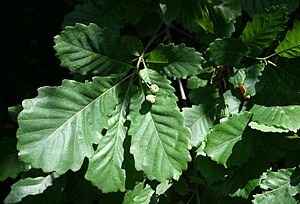Hartwiss oak
| Hartwiss oak | ||||||||||||
|---|---|---|---|---|---|---|---|---|---|---|---|---|

Leaves and unripe fruits |
||||||||||||
| Systematics | ||||||||||||
|
||||||||||||
| Scientific name | ||||||||||||
| Quercus hartwissiana | ||||||||||||
| Steven |
The Hartwiss oak ( Quercus hartwissiana Steven ) is a deciduous tree - species from the genus of oaks ( Quercus ) in the beech family (Fagaceae). It was named in 1857 by Christian von Steven after Nikolai Andrei von Hartwiss , director of the Nikita Botanical Garden near Yalta .
description
The Hartwiss oak is a 10 to 25 (up to 35) m high deciduous tree with an umbrella-shaped crown and ascending branches. Their bark is thick, longitudinally fissured, almost black. The young shoots are dark reddish-brown and glabrous. The buds are broadly oval or almost round, 6 to 7 mm long, with short ciliate scales. The petiole is 1.5 to 2 cm long. The leaf blades are up to 12 (to 14) cm long and up to 7 (to 9) cm wide, obovate or elongated, indistinctly heart-shaped at the base and have seven to ten pairs of fairly regular, short, rounded to pointed lobes. They have (8 to) 9 to 12 (to 14) pairs of straight, parallel side veins. The leaf veins are all aligned with the lobes of the leaf, not the indentations in between. The upper side of the leaf is shiny green and bare, the underside more matt, with a dark brown shade, with a grayish, fine down and somewhat longer reddish hairs along the leaf veins or in the corners in between.
One to four acorns can hang from a 2 to 7 cm long stem. Their fruits ripen in the first year. The acorns are 2.5 to 3 cm long and 1.2 to 1.5 cm wide, the fruit cups measure 1.5 cm in length and 2 cm in diameter. The scales of the fruit cup are grown together almost to the tip. The tepals of the male flowers found in catkins are divided almost to the base.
Occurrence
The Hartwiss oak is a colchic floral element whose distribution area extends along the south and east coast of the Black Sea . It occurs in Europe in south-east Bulgaria ( Strandscha Nature Park ) and in European Turkey , furthermore in northern Anatolia and in western Transcaucasia and the Caucasus . According to information from Kostadinov and Brostilova, who published a map of the natural range of the Hartwiss oak in the Strandscha Mountains in 1979, two ecotypes of this species can be distinguished: one that occurs in dense forests on alluvial soils of rivers, while the other occurs on thin karst soils grows. In Russia it occurs in the basin of the Msymta River and in the North Caucasus, in Georgia mainly in western Georgia ( Abkhazia , Racha-Letschchumi , Megrelia , Imereti , Guria and Adjara ); from East Georgia it is only known from Inner Kakheti (Babaneuri) today.
Of the Caucasian oaks, the Hartwiss oak tolerates the most shade. It does not occur in pure stands, but always mixed with other deciduous tree species, for example in the broad-leaved forests of the Colchis in locations with a warm and humid climate on fresh to moist soils from the lowlands to an altitude of 1200 to 1500 m.
Systematics
Quercus hartwissiana Steven was first described by Christian von Steven in 1857 . Important synonyms are Quercus armeniaca Kotschy and Quercus stranjensis Turrill . It is related to the English oak ( Quercus robur ) and the grape oak ( Quercus petraea ).
literature
- Sergej Jakovlevic Sokolov, AI Stratonovich: Род 6. Quercus - Дуб (genus 6: Quercus - oak.) In: Sergej Jakovlevic Sokolov: Деревья и кустарники СССР. Дикорастущие, культивируемые и перспективные для интродукции ( Trees and shrubs of the USSR. Wild, cultivated and promising for introduction ). Volume 2 - Покрытосеменные ( angiosperms ). Academy of Sciences of the USSR, Moscow 1951, pp. 467–468, DJVU file, (Russian).
Individual evidence
- ↑ a b c d e f Peter A. Schmidt: Trees and bushes of the Caucasus. Part III: Deciduous trees of the Ebenaceae families (Ebony family) to Frankeniaceae (Franconian family). In: Communications of the German Dendrological Society. Volume 89, 2004, ISBN 3-8001-8324-2 , pp. 49-71 (here: p. 63).
- ↑ a b Christian von Steven: Directory of the plants growing wild on the Tauride Peninsula (Continuatio). (Primulaceae - Cupressaceae). In: Bulletin de la Société impériale des naturalistes de Moscou. Volume 30, No. 2, pp. 325–398 (here: p. 387), preview in the Google book search.
- ↑ a b c d e Ian C. Hedge, Faik Yaltırık: Quercus. In: Peter Hadland Davis (Ed.): Flora of Turkey and the East Aegean Islands. Vol. 7 (Orobanchaceae to Rubiaceae) . Edinburgh University Press, Edinburgh 1982, ISBN 0-85224-396-0 , pp. 664 .
- ↑ a b c Oleg Polunin: Flowers of Greece and the Balkans - a field guide. Oxford University Press, Oxford et al. 1988, ISBN 0-19-281998-4 , p. 288 (reprinted from 1980).
- ↑ Kostadin Kostadinov, Maria Brostilova: The area of Quercus hartwissiana (Fagaceae) and opportunities of its extension in Bulgaria. In: Bocconea. Volume 5, 1997, ISSN 1120-4060 , pp. 487-491, PDF file .